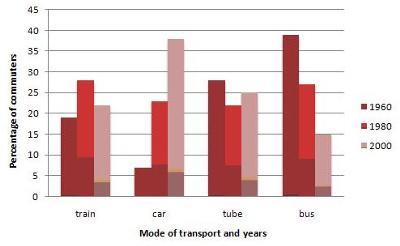IELTS Sample Task 1: Travel to and from Work
by Ramesh
(India)

The graph shows the different modes of transport used to travel to and from work in one European city in 1960, 1980 and 2000.
Write a report for a university lecturer describing the information below.
· You should write at least 150 words.
· You should spend about 20 minutes on this task.
The bar chart shows four times of vehicles used to travel and from work place in three different years (1960,1980,2000)in one of the city in Europe.
Overall, use of car increased over three years,while the use of bus declined.The figure for train and tube fluctuated.
In 1960,most of the commuters travelled to and from work by bus,with slightly less than 40%.on the other hand,only small amount of employee used car,at around 7%.At the same time,the percentage of commuters who used tubes and trains were 27% and 18% respectively.
In 1980,the figure for people using train to go work rose to 27%,but fell back to 22% in 2000.In contrast, number of people who went to work by tubes decreased by 5% in 1980,before reaching to 25% in 2000.
Employee travelled to work by car rose, and reached at 37% in 2000,whereas commuters number dropped to 15% at the end of period.
AGAIN REQUEST FOR CORRECTION ASAP.
THANKS IN ADVANCE.
MUCH APPRICIATED.
==================================================
IELTS buddy
Feedback
Here is a corrected version:
The bar chart shows four times types of vehicles used to travel and from to work place in three different years (1960,1980,2000) in one of the city in Europe.
Overall, use of car use increased
over the three years, while the use of buses declined. The figures for the train and the tube fluctuated.
In 1960, most of the commuters travelled to and from work by bus, with slightly less than 40%. On the other hand, only a small amount of employees used cars, at around 7%. At the same time, the percentage of commuters who used tubes and trains were 27% and 18% respectively.
In 1980, the figure for people using trains to go to work rose to 27%, but fell back to 22% in 2000. In contrast, the number of people who went to work by tube decreased by 5% in 1980, before reaching to 25% in 2000.
Employees travelling to work by car rose, and reached at a peak of 37% in 2000, whereas bus commuting numbers dropped to 15% at the end of period.
==================================================
Further Comments
Overall its a good answer as you have identified and compared all the key information.
You also have a mix of complex structures. You must have some of these to get a higher score.
One of the key points to get a good score for 'task response' for the Task 1 is to make sure you categorize / group information appropriately so it is easy to follow and read and this also shows you have good analytical skills.
Check out this link about this:
Writing a Task 1
